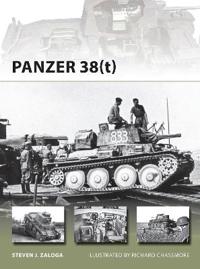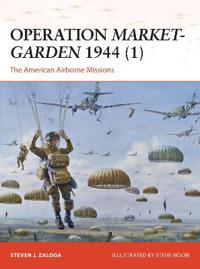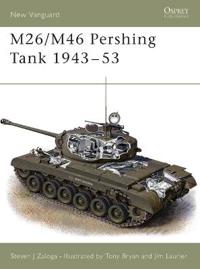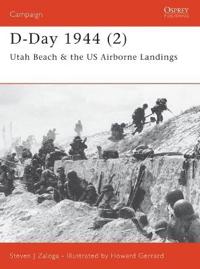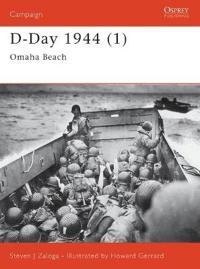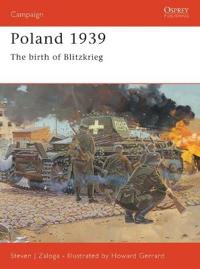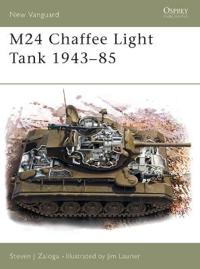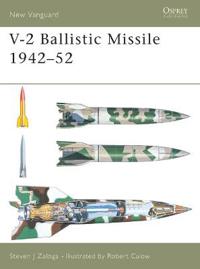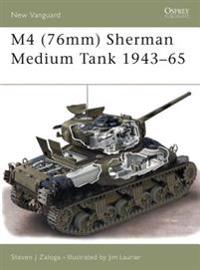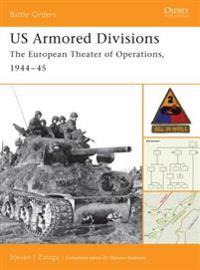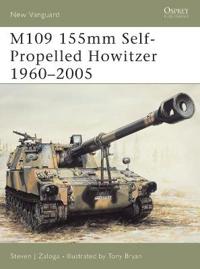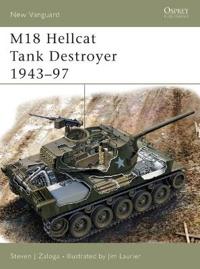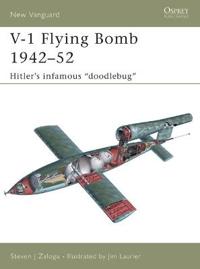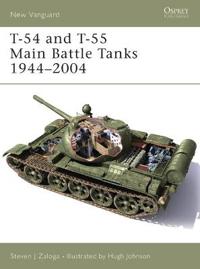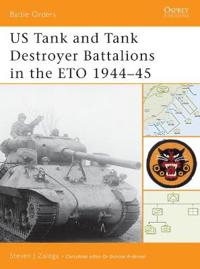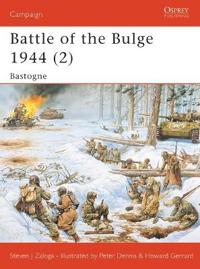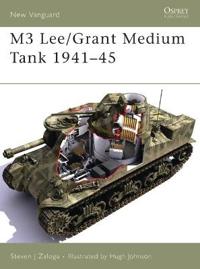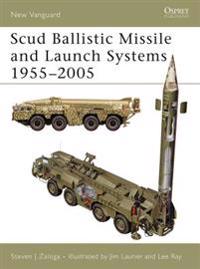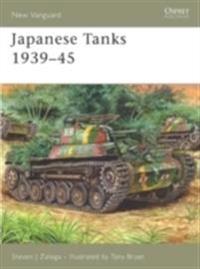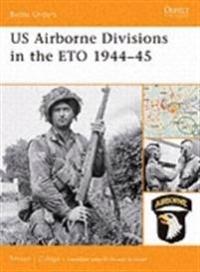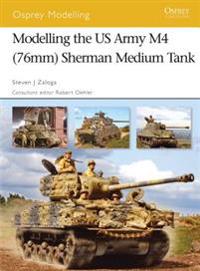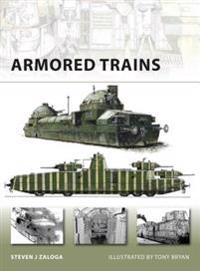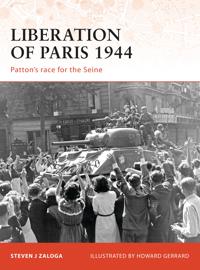Panzer 38t (Häftad)
avSteven J. Zaloga
ISBN: 9781782003953 - UTGIVEN: 2014-10This title offers a detailed study of a successful but little-known German tank of World War II, the Panzer 38(t). Germany's annexation of Czech provinces in 1938 gave it control of the large Czech armament industry, one of the jewels of which was the very modern LT 38 tank. The type was fully integ[...]
Operation Market-Garden 1944 1 (Häftad)
avSteven J. Zaloga
ISBN: 9781782008163 - UTGIVEN: 2014-08In the summer of 1944, plans began for a complex operation to seize a Rhine river bridge at Arnhem in the Netherlands. The American portion of the airborne mission was to employ two divisions of the US XVIII Airborne Corps to seize key terrain features that otherwise might delay the advance of Briti[...]
M26/M46 Pershing Tank 1943-1953 (Häftad)
avSteven J. Zaloga
ISBN: 9781841762029 - UTGIVEN: 200011From the moment that the M4 Sherman had been matched against German Panther and Tiger tanks, the American tank crews had known that their vehicles were outclassed by the opposition. What was needed was a more powerful tank, more heavily armed and armored, that could take-on the powerful German panze[...]
D-Day 1944 (Häftad)
avSteven J. Zaloga
ISBN: 9781841763651 - UTGIVEN: 200402The D-Day landings of 6 June 1944 were the largest amphibious military operation ever mounted. During the late spring and early summer of 1944 the roads and ports of Southern England were thronged with the troops, vehicles and ships of the invasion force. The greatest armada the world had ever seen [...]
D-Day 1944 (Häftad)
avSteven J. Zaloga
ISBN: 9781841763675 - UTGIVEN: 200307The D-Day landings of 6 June 1944 were the largest amphibious military operation ever mounted. During the late Spring and early summer of 1944 the roads and ports of southern England were thronged with the troops, vehicles and ships of the invasion force. The greatest armada the world had ever seen [...]
Poland 1939 (Häftad)
avSteven J. Zaloga
ISBN: 9781841764085 - UTGIVEN: 200208The German invasion of Poland on 1 September 1939 began World War II in Europe. The outcome of the campaign was a foregone conclusion. It pitted the newly modernized army of Europe's great industrial power against the much smaller Polish army. To further tip the scales, Germany signed a pact with th[...]
M24 Chaffee Light Tank 1943-70 (Häftad)
avSteven J. Zaloga
ISBN: 9781841765402 - UTGIVEN: 200306The history of US light tanks during World War II is a chequered one. The Light Battalions of US Armored Divisions were initially filled with M3A1 and M5 Stuart tanks, however, on the battlefields of North Africa it was realised that these were disastrously under armoured and gunned, and a replaceme[...]
V-2 Ballistic Missile 1944-54 (Häftad)
avSteven J. Zaloga
ISBN: 9781841765419 - UTGIVEN: 200308The German A-4 ballistic missile, better known by its propaganda name of V-2, was the world's first successful ballistic missile, breaking through the atmosphere to reach its target quicker. It was a forerunner of Cold War ballistic missiles and its combat use in 1944-45 set the pattern for the use [...]
M4 (76mm) Sherman Medium Tank 1943-53 (Häftad)
avSteven J. Zaloga
ISBN: 9781841765426 - UTGIVEN: 200304The M4 Sherman tank was the mainstay of the Western allies between 1942 and 1945. Fast and modern it was a big success and was transported as far afield as Russia and North Africa. The American Chief of Staff claimed in November 1943 it was 'hailed widely as the best tank on the battlefield today...[...]
Us Armored Divisions (Häftad)
avSteven J. Zaloga
ISBN: 9781841765648 - UTGIVEN: 200403The armored division were the shock force of the US Army's combat formulations during the fighting in northwest Europe in the final year of the war. This book examines the combat mission of the armored division in the US Army wartime doctrine. The organization of the US armored division is examined,[...]
M109 155mm Self-propelled Howitzer (Häftad)
avSteven J. Zaloga
ISBN: 9781841766317 - UTGIVEN: 200502Entering service in the early 1960s, the M109 Self-Propelled Howitzer has been in production for 34 years and forms the backbone of US Army and Reserve artillery units. The M109A6 is the latest development of the M109 series and incorporates advanced fire control systems that enable it to have the f[...]
M18 Hellcat Tank Destroyer 1943-97 (Häftad)
avSteven J. Zaloga
ISBN: 9781841766874 - UTGIVEN: 200404The M18 76mm Gun Motor Carriage was developed for the US Army's Tank Destroyer Command. It was the only tank destroyer deployed during World War II actually based on their requirements for speed and firepower. This book examines the development of this vehicle, the controversies over the need for hi[...]
V-1 Flying "Buzz" Bomb, 1942-52 (Häftad)
avSteven J. Zaloga
ISBN: 9781841767918 - UTGIVEN: 200501The first deployment of the V-1 was in June 1944 when, following two years of tests, Hitler gave the order to attack England. Known to the Allies as the "Buzz Bomb" or "Doodlebug", the V-1 was the world's first cruise missile. This book explores the V-1 in detail, from its initial concept, first use[...]
T-54 and T-55 Main Battle Tanks 1958-2004 (Häftad)
avSteven J. Zaloga
ISBN: 9781841767925 - UTGIVEN: 200407The T-54 and T-55 tanks are the most widely manufactured tanks of all time. They have become ubiquitous to wars around the globe since the 1950s, starting with Hungary in 1956, and including the Arab-Israeli wars of 1967, 1973 and 1982, the Vietnam war of 1967-75, the Iran-Iraq War of 1980-88, the A[...]
US Tank And Tank Destroyer Battalions in the Eto 1944?45 (Pocket)
avSteven J. Zaloga
ISBN: 9781841767987 - UTGIVEN: 2005-01Although they are less well known than the more glamorous armored divisions, vast numbers of separate tank and tank destroyer battalions were in service in the European Theater of Operations from 1944 to 1945, engaged in supporting the infantry divisions. This title focuses on these units: the stand[...]
Battle of the Bulge 1944 (Häftad)
avSteven J. Zaloga
ISBN: 9781841768106 - UTGIVEN: 200411The Battle of the Bulge was the largest and most costly battle fought by the US Army in World War II. The Ardennes fighting was Hitler's last gamble on the Western Front, crippling the Wehrmacht in the West for the remainder of the war. This volume offers a fresh analysis of this crucial battle. Fol[...]
M3 Lee/Grant Medium Tank 1941-45 (Häftad)
avSteven J. Zaloga
ISBN: 9781841768892 - UTGIVEN: 200508The highly successful 'stop-gap' M3 medium tank was designed in 1941, and as adequate turret casting facilities were not yet ready, the M3 used an unusual armament configuration patterned after a French tank. British lend-lease demands led to the design of a second turret type with the US version ca[...]
Scud Ballistic Missile and Launch Systems 1955-2005 (Häftad)
avSteven J. Zaloga
ISBN: 9781841769479 - UTGIVEN: 200602The Scud has become a symbol of the changing nature of warfare in the aftermath of the Cold War, as its original development was part of a Soviet plan to fight a nuclear war in the heart of Europe. When Iraqi armed forces were nearly helpless in the face of the Coalition forces in the 1991 Gulf War,[...]
Remagen 1945 (Häftad)
avSteven J. Zaloga
ISBN: 9781846030185 - UTGIVEN: 200610In the aftermath of the battle of the Ardennes in February 1945, the Allies began steps for the final assault into Germany. The Rhine represented the last major geographical barrier to the Allied advance into Germany. In the event, fortune smiled on the US Army when the 9th Armored Division unexpect[...]
Japanese Tanks 1939-45 (Häftad)
avSteven J. Zaloga
ISBN: 9781846030918 - UTGIVEN: 200708Contrary to popular belief, the Japanese Army widely employed tanks within the Pacific theater of war. This title details their key role in the conquests of Singapore and Malaya, as well as their later use in Burma, Saipan, and the Philippines, including in the amphibious assault of Corregidor. The [...]
US Airborne Divisions in the ETO 1944-45 (Pocket)
avSteven J. Zaloga
ISBN: 9781846031182 - UTGIVEN: 200703The delivery of entire divisions to battlefields behind enemy lines by parachute and glider was a unique feature of World War II. This book covers the mature phase of these operations from the tactical failures of night-time drops at D-Day, through the daylight jumps at Arnhem and the Rhine, to the [...]
Modelling the Us Army M4 (76mm) Sherman Medium Tank (Häftad)
avSteven J. Zaloga
ISBN: 9781846031205 - UTGIVEN: 2007-10The Sherman tank was the principal US and Allied tank of World War II - more Shermans were built than all German tanks combined. Not only were large numbers of Shermans manufactured, but a large number of variants emerged powered by different types of engines and with different types of hulls, turre[...]
Armored Trains (Häftad)
avSteven J. Zaloga
ISBN: 9781846032424 - UTGIVEN: 200801First seen during the American Civil War and later appearing in the Franco-Prussian War and the Boer Wars, the military use of the armoured train only came to the fore during World War I, reigning supreme on the Eastern Front. Deployed widely during Russian Civil War the technology spilt over into t[...]
Liberation of Paris 1944 (Häftad)
avSteven J. Zaloga
ISBN: 9781846032462 - UTGIVEN: 200804In July 1944 of World War II (1939-1945), Operation "Cobra" broke the stalemate in Normandy and sent the Allies racing across France. The Allied commanders ignored Paris in their planning for this campaign, considering that the risk of intense street fighting and heavy casualties outweighed the city[...]
Panther vs Sherman (Pocket)
avSteven J. Zaloga
ISBN: 9781846032929 - UTGIVEN: 200809In this book Steven J Zaloga offers a fascinating comparison of the combat performance of the two most important tanks involved in the crucial fighting of 1944, the Sherman and the Panther. Examining the design and development of both tanks, Zaloga notes the obvious superiority that the Panther had [...]

